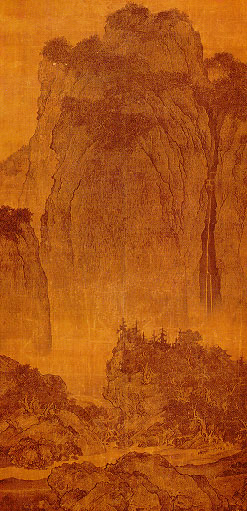|
| |
. . . What, exactly,
is shifting in this paradigm ?
Four Theatres of Perspectival
Change
Number ONE :
COMMUNICATION
BETWEEN
SCIENCE AND
RELIGION

Fan K'uan "Travelers on a
Mountain Path"
c. early 11th century, Sung dynasty
"Great national Treasures of China"
Masterworks in the National Palace
Museum
http://www.cca.gov.tw/Culture/museum/npmtr/B1114/B111405/index.htm
Physicists, biologists, astronomers,
theologians, priests, ministers and shamans are meeting at the same seminar tables in a
spirit –unimaginable a few decades ago– of curiosity about each other and their
relationship. Often perceived as adversaries, science and religion begin to appear less
contradictory and increasingly compatible and complementary.
While rapprochement may be distant,
notice is being taken of some affinities, in both method and content.
In method for example:
- Shared epistemological traits are
identified in patterns of reasoning and in a fiduciary and axiomatic basis for both
religion and science.
- Older, rigid subject-object distinctions
are reconsidered. Naive notions of objectivity become problematic in, for instance,
measurements in quantum physics.
- At the same time, our understanding of
reasoning itself has evolved. The idea of rationality itself has matured to some degree.
The work of Polanyi, Quine, Lakatos (to name three) brings the sciences out of
an artificial ghetto of empiricist-analytic logic. Godel’s Theorem (that
logical systems reference each other) suggests relationship and interdependency among
explanatory systems.
In content for example:
- Seventeenth century physics, with its
conceptions of space and time as absolute, is superceded by the physics of the twentieth
century in which spacetime is relative. These and collateral developments offer a
cosmology compatible with key Christian doctrines (e.g., the Incarnation), where the
earlier Enlightenment physics appeared to negate them.
- Previous discussions of freewill and
determinism, haunted by the specter of a Laplacian universe, move to new level, inspired
partly by new models from the sciences. Fractals, for instance, offer a model of apparent
"free," that is, not precisely predictable, variations on a standing pattern.
Quantum mechanics requires consideration of randomness written into nature at the
particle level. While such discoveries, applied or theoretical, complicate the questions
rather than answer them, they radically alter the backdrop and the conceptual repertoire
of the debate.
- Developments in the life sciences (e.g.,
genetics research; positron mapping of brain functions) are changing the terms under which
we discuss the nature of human being in light of old conundrums such as personal identity
and the mind-body problem. At the same time, at the frontiers of science, observations are
made about such things as the nature and extended limits of perception, and about
spiritual influence upon physical health.
- With a century of modern psychological
exploration behind us, the secular concept of the "self" is evolving. For
example, a uni-dimensional determination of identity is giving way to one which is
many-sided, whose complexity and flexibility requires moral anchorage yet is incompatible
with fundamentalism.
- As in medicine, some mental health
researchers and practitioners have begun to take an interest in the resources of spiritual
teachings and traditions in the interpretation of selfhood, personal growth and
psychological health.
A metamorphosis of images highlights a
transformation in our ideas of the self within society. "Linearity" is used
pejoratively. In its place in our thinking and imaging, researchers turn to metaphors that
give us three-dimensional, interlocking pictures. Terms such as "web" and
"weave" take the place of terms of rank for relationships and for moral
reasoning. Holographic metaphors and the language of "network" for instance, are
used for the physiology of memory, for information processing from external environment to
internal thought, and for analysis of multiple causes
Please read
on . . .

|